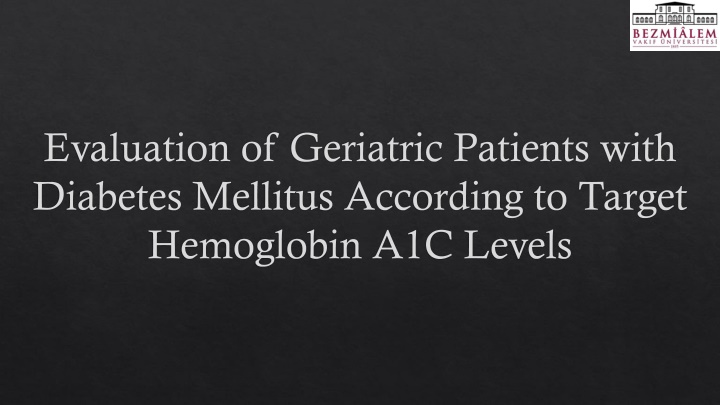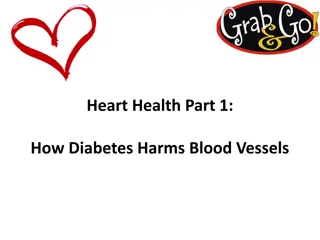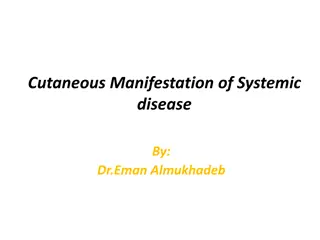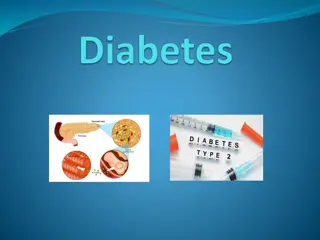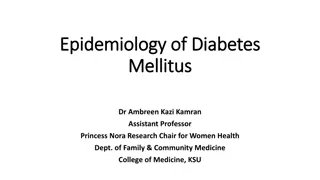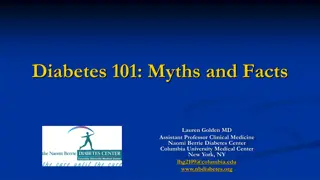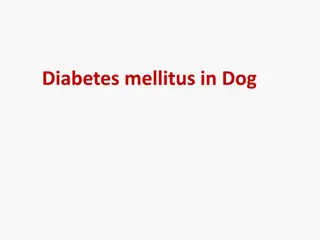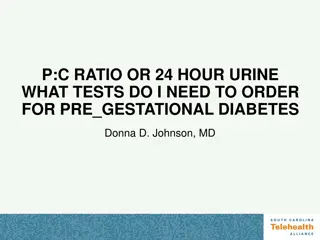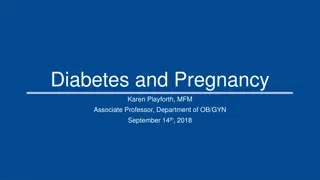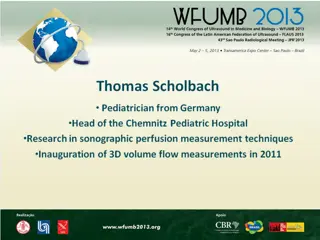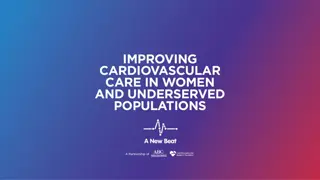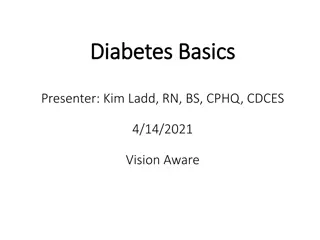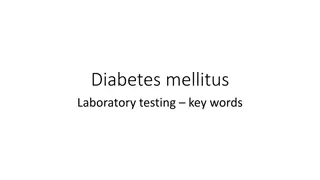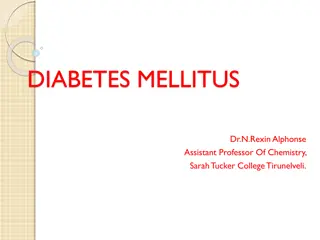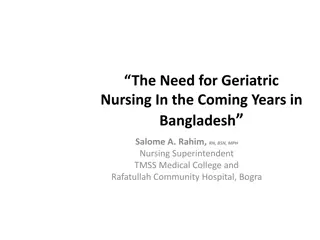Evaluation of Geriatric Patients with Diabetes Mellitus: Target Hemoglobin A1C Levels
Diabetes Mellitus is prevalent among older individuals, impacting mortality rates and functional disability. This study assesses hemoglobin A1C levels in geriatric patients with diabetes, considering optimal treatment strategies and glycemic targets based on individualized care needs to reduce complications and enhance quality of life.
Download Presentation

Please find below an Image/Link to download the presentation.
The content on the website is provided AS IS for your information and personal use only. It may not be sold, licensed, or shared on other websites without obtaining consent from the author.If you encounter any issues during the download, it is possible that the publisher has removed the file from their server.
You are allowed to download the files provided on this website for personal or commercial use, subject to the condition that they are used lawfully. All files are the property of their respective owners.
The content on the website is provided AS IS for your information and personal use only. It may not be sold, licensed, or shared on other websites without obtaining consent from the author.
E N D
Presentation Transcript
Evaluation of Geriatric Patients with Diabetes Mellitus According to Target Hemoglobin A1C Levels
INTRODUCTION Diabetes Mellitus is a highly prevelant and important health condition among older individuals ( 65 years) Older patients with uncontrolled diabetes have higher rates of premature death, functional disability and coexisting illnesses. According to Turkish Endocrinology and Metabolism Society, approximately one-third of people over the age of 65 years have diabetes and one-half of older individuals have prediabetes in Turkey. Yet glucose management in this population is ill-defined and thus geriatric patients with diabetes mellitus don t receive an optimal treatment.
INTRODUCTION The American Diabetes Association advises an HbA1c level to be of less than 7% as the American Association of Clinical Endocrinologists recommends an HbA1c level to be of less than 6.5% for younger, healthier adults. However, geriatric population with complex comorbidities, may derive less benefit from excessive strategies to lower glucose levels and are more susceptible to hypoglycemia and its consequences. Current recommendations for diabetes management endorse higher glycemic targets for older patients with multiple comorbidities, functional impairments and limited life expectancy and suggest individualized glycemic targets The reasons for higher glycemic targets in these patients have 2 aspects: intensive glycemic control is unlikely to result in benefit but it is associated with a risk for harm.
AIM To identify patients who had tightly or poorly controlled diabetes mellitus and therefore at risk for diabetes complications.
METHOD Retrospective cross-sectional analysis of the data on 548 geriatric patients with diabetes admitted to Bezmialem Foundation University Hospital from 2019 through 2020 who were receiving diabetes medications and had a HbA1c measurement. Patients having at least one of the following additional criteria: aged 80 years + , dependent (based on the Lawton scale or Barthel index) , with history of cardiovascular or vascular complications, diagnosed with dementia or with end-stage kidney failure were placed in the high risk of hypoglycemia" group .
METHOD HbA1c levels were divided into 4 groups and two of these groups were considered to be as a subdivision of a single group: tight glycemic control (6.5<) , acceptable glycemic control (6.5-7.5) , acceptable glycemic control (7.5-8.5) , poor glycemic control (8.5>) . The influence of diabetes medications, functional statues and coexisting diseases on HbA1c levels and group at risk for hypoglycemia was analyzed. Tight glycemic control Poor glycemic control Acceptable glycemic control 6.5< 6.5-7.5 7.5-8.5 8.5> Not Optimal for low risk patients Optimal for high risk patients Not recommended recommended
RESULTS Of 548 older patients with diabetes (aged 76 7.2) , %65.3 were receiving metformin, %33.6 long acting ins lin, %27.6 dpp-4 inhibitors, %19.2 sulfonylurea. 32.7 percent of patients had tight glycemic control (HbA1c <6.5) and 22.2 percent of patients had poor glycemic control (HbA1c 8.5>)
RESULTS 53.5 percent of patients were at risk for hypoglycemia. Patients having at least one of the following additional criteria: aged 80 years + , dependent (based on the Lawton scale or Barthel index) , with history of cardiovascular or vascular complications, diagnosed with dementia or with end-stage kidney failure were placed in the high risk of hypoglycemia" group .
RESULTS Evaluation of patients with diabetes mellitus according to the target HbA1c Levels 21% 24% 22% 33% Optimal Tight Poor Suboptimal
RESULTS Significant association was present between the risk of hypoglycemia and HbA1c groups (p<0.01) Patients with tightly controlled diabetes were more likely to be in risk of hypoglycemia group and patients with poorly controlled diabetes were less likely to be in risk of hypoglycemia group.
RESULTS The group of people with tightly controlled diabetes mellitus (HbA1C 6.5%) did not differ significantly in terms of functional status from people with higher HbA1C values. (p>0.1)
RESULTS A significant independent negative effect associated with the lower values of HbA1c was observed among patients on insulin (odds ratio, 0.16) The other diabetes medications as in metformin, sulfonylureas, SGLT-2 inhibitors, GLP-1 agonists had no significant influence on the distribution of HbA1c groups (p>0.05)
CONCLUSIONS Our research did find that diabetes therapy was not individualized in geriatric population. Only small percent of patients were receiving optimal treatment based on their risk status. We need to give more attention to the their treatment regimen and prevent them from adverse drug events.
THANK YOU FOR LISTENING S leyman Talha zden Mentor: P nar Soysal
REFERENCES 1. Centers for Disease Control and Prevention. National Diabetes Statistics Report [Internet], 2017. 2. American Diabetes Association. 12. Older adults: Standards of Medical Care in Diabetes-2019. Diabetes Care 2019;42 (Suppl. 1):S139 S147 3. Kirkman MS, Briscoe VJ, Clark N, et al. Diabetes in older adults. Diabetes Care 2012;35: 2650 2664 4. Lipska KJ, Ross JS, Miao Y, Shah ND, Lee SJ, Steinman MA. Potential Overtreatment of Diabetes Mellitus in Older Adults With Tight Glycemic Control. JAMA Intern Med. 2015;175(3):356 362 5. Budnitz DS, Lovegrove MC, Shehab N, Richards CL. Emergency hospitalizations for adverse drug events in older Americans. N Engl J Med. 2011;365(21):2002-2012. 6. Lipska KJ, Ross JS, Wang Y, et al. National Trends in US Hospital Admissions for Hyperglycemia and Hypoglycemia Among Medicare Beneficiaries, 1999 to 2011. JAMA Intern Med. 2014;174(7):1116 1124 7. Wojszel, Z.B., Kasiukiewicz, A. A retrospective cross-sectional study of type 2 diabetes overtreatment in patients admitted to the geriatric ward. BMC Geriatr 19, 242 (2019) doi:10.1186/s12877-019-1256-2
